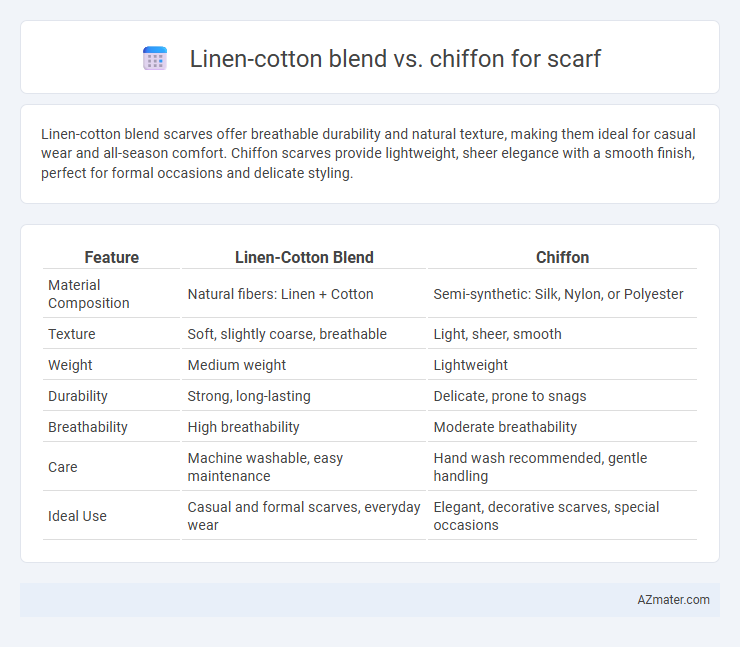Linen-cotton blend scarves offer breathable durability and natural texture, making them ideal for casual wear and all-season comfort. Chiffon scarves provide lightweight, sheer elegance with a smooth finish, perfect for formal occasions and delicate styling.
Table of Comparison
| Feature | Linen-Cotton Blend | Chiffon |
|---|---|---|
| Material Composition | Natural fibers: Linen + Cotton | Semi-synthetic: Silk, Nylon, or Polyester |
| Texture | Soft, slightly coarse, breathable | Light, sheer, smooth |
| Weight | Medium weight | Lightweight |
| Durability | Strong, long-lasting | Delicate, prone to snags |
| Breathability | High breathability | Moderate breathability |
| Care | Machine washable, easy maintenance | Hand wash recommended, gentle handling |
| Ideal Use | Casual and formal scarves, everyday wear | Elegant, decorative scarves, special occasions |
Introduction to Linen-Cotton Blend and Chiffon Scarves
Linen-cotton blend scarves offer a breathable, durable fabric with a natural texture ideal for everyday wear and warmer climates, combining the absorbency of cotton with linen's strength. Chiffon scarves provide a lightweight, sheer fabric with a soft, flowing drape, perfect for elegant, formal occasions or layering without adding bulk. Both materials present distinct tactile and visual characteristics, catering to different style preferences and functional needs.
Fabric Composition and Characteristics
Linen-cotton blend scarves combine the breathability and crisp texture of linen with the softness and durability of cotton, offering a natural, lightweight fabric that is highly absorbent and ideal for warm climates. Chiffon scarves are crafted from sheer, lightweight silk or synthetic fibers, characterized by a delicate, translucent appearance and a smooth, flowy drape that adds elegance and softness. The linen-cotton blend provides a matte finish with a slightly coarse texture, while chiffon boasts a silky sheen and a fluid, airy feel perfect for dressier or layered scarf styles.
Breathability and Comfort Comparison
Linen-cotton blend scarves offer superior breathability due to the natural cellulose fibers, allowing excellent air circulation and moisture absorption for enhanced comfort in warm weather. Chiffon, typically made from silk or synthetic fibers, provides a lightweight and smooth texture but may trap heat and moisture, reducing breathability. For all-day wear in hot climates, linen-cotton blends outperform chiffon by maintaining dryness and preventing skin irritation.
Texture and Feel on Skin
Linen-cotton blend scarves offer a breathable, slightly coarse texture that softens with wear, providing a natural, matte feel ideal for casual, everyday comfort. Chiffon scarves feature a lightweight, smooth, and sheer texture, delivering a delicate, silky sensation perfect for elegant, dressy occasions. The linen-cotton blend is more absorbent and breathable, while chiffon excels in a cool, airy feel against the skin.
Durability and Maintenance Needs
Linen-cotton blend scarves offer superior durability due to the strong natural fibers that resist wear and tear, making them ideal for everyday use. They require minimal maintenance, often machine washable and less prone to delicate fabric damage compared to chiffon. Chiffon scarves, while lightweight and elegant, are more fragile and demand careful hand washing and gentle handling to prevent snags and fiber weakening.
Style Versatility and Aesthetic Appeal
Linen-cotton blend scarves offer a natural, textured look that pairs well with casual and rustic styles, providing durability and breathability ideal for everyday wear. Chiffon scarves feature a lightweight, sheer fabric that drapes elegantly, enhancing formal and sophisticated outfits with a soft, flowing aesthetic. Both materials enhance style versatility, with linen-cotton suited for relaxed, earthy ensembles and chiffon ideal for adding delicate refinement to dressier looks.
Seasonal Suitability: Which is Best When?
Linen-cotton blend scarves excel in warm and transitional seasons due to their breathability and moisture-wicking properties, making them ideal for spring and summer wear. Chiffon scarves offer lightweight elegance and a slightly sheer texture, suitable for spring and early autumn when temperatures are moderate but not excessively hot. For winter or colder months, neither fabric is ideal for warmth, but layering chiffon can add a stylish touch without bulk, while linen-cotton remains best suited to temperate climates.
Cost and Accessibility
Linen-cotton blend scarves offer an affordable option with high durability and breathability, making them accessible for everyday wear and easy care. Chiffon scarves, typically made from synthetic or silk fibers, tend to be more expensive due to their delicate texture and elegant appearance, often requiring special handling. Accessibility for chiffon is limited by its higher cost and maintenance needs, whereas linen-cotton blends are widely available and budget-friendly.
Sustainability and Eco-Friendliness
Linen-cotton blend scarves offer superior sustainability due to their natural fibers, renewable sourcing, and high biodegradability, reducing environmental impact during production and disposal. Chiffon, often made from synthetic fibers like polyester, poses challenges for eco-friendliness as it is non-biodegradable and relies on petroleum-based resources, contributing to microplastic pollution. Choosing linen-cotton blend supports eco-conscious fashion with its lower carbon footprint and sustainable harvesting methods compared to the synthetic and less sustainable chiffon alternatives.
Final Verdict: Choosing the Right Scarf Fabric
Linen-cotton blends offer durability, breathability, and a natural texture ideal for everyday wear, while chiffon provides a lightweight, sheer, and elegant finish suited for formal occasions. For versatile, casual scarves that withstand frequent use, linen-cotton blends are recommended, whereas chiffon excels in adding an airy, delicate touch to sophisticated outfits. Selecting the right fabric depends on the intended use, with linen-cotton blending comfort and resilience, and chiffon prioritizing softness and visual appeal.

Infographic: Linen-cotton blend vs Chiffon for Scarf
 azmater.com
azmater.com